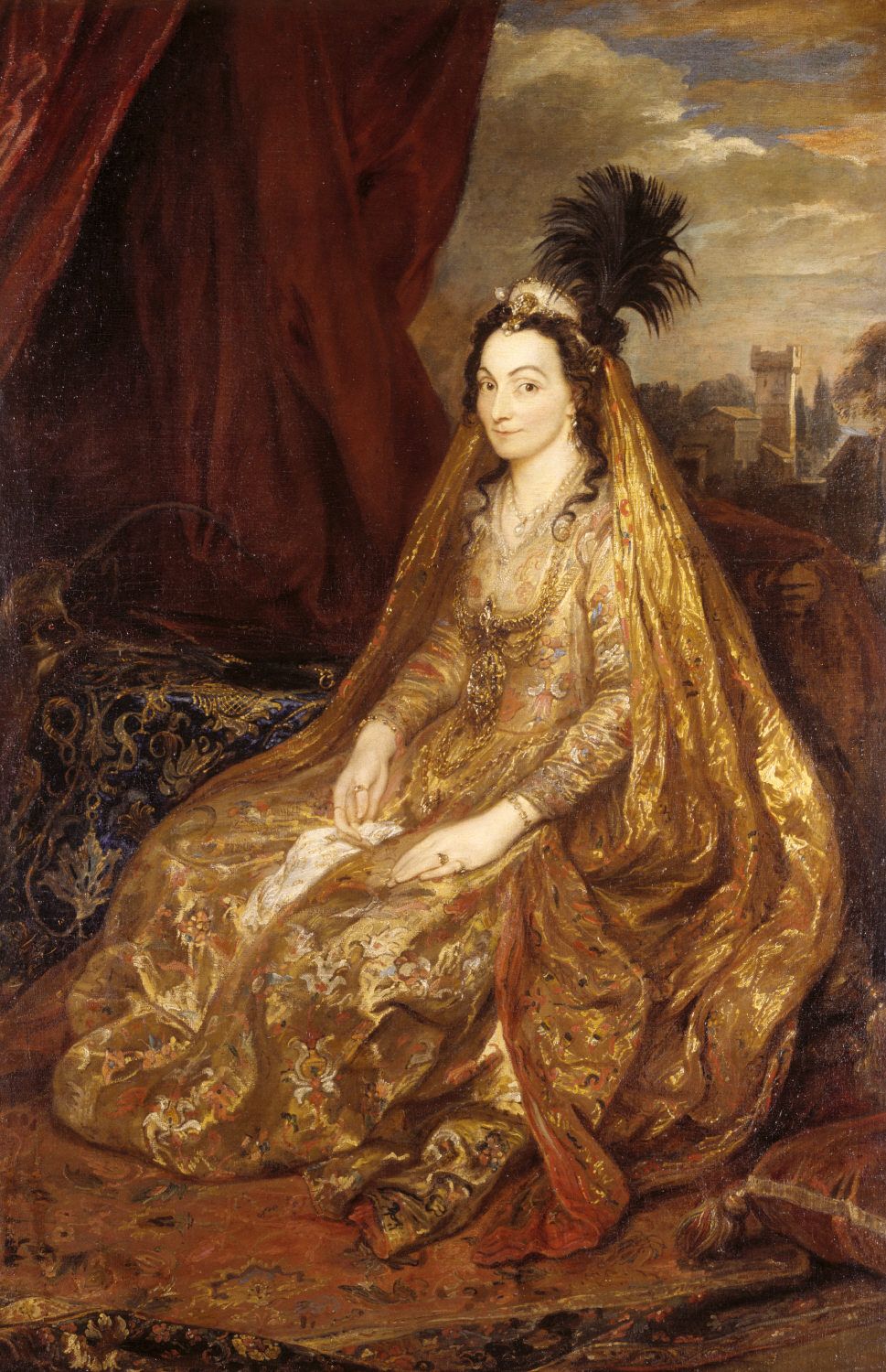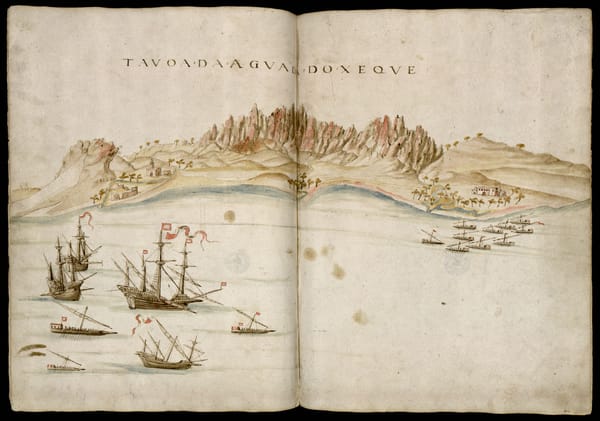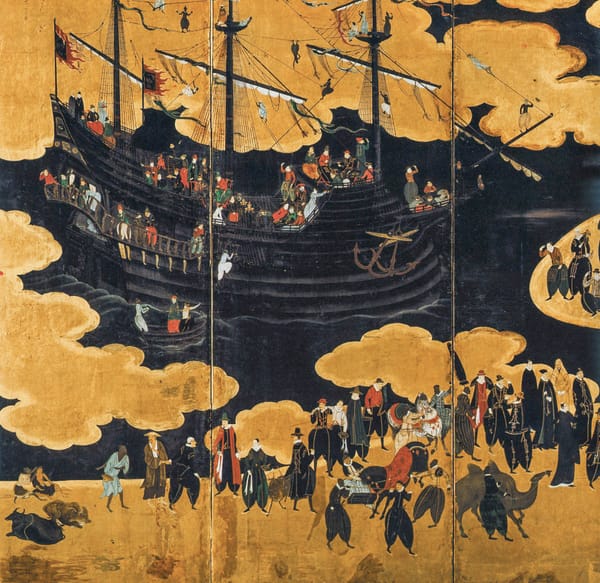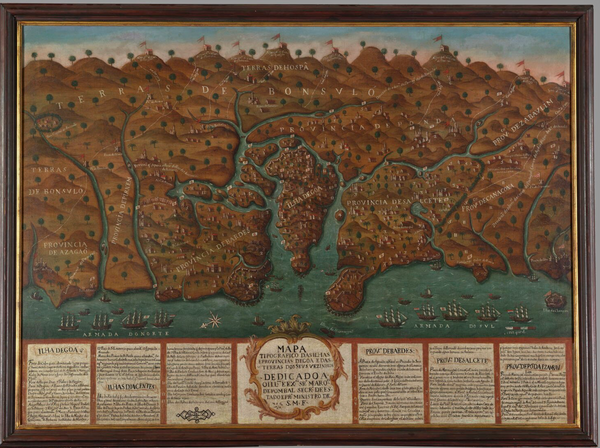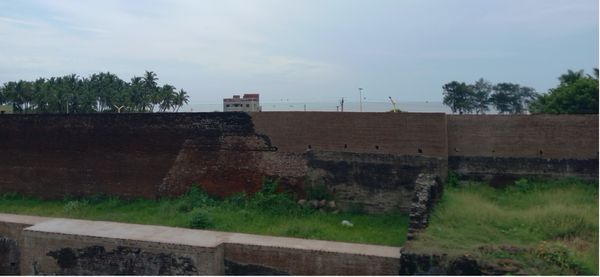Silk routes and Persian connections: the adventures of the Shirley brothers and the nascent East India Company
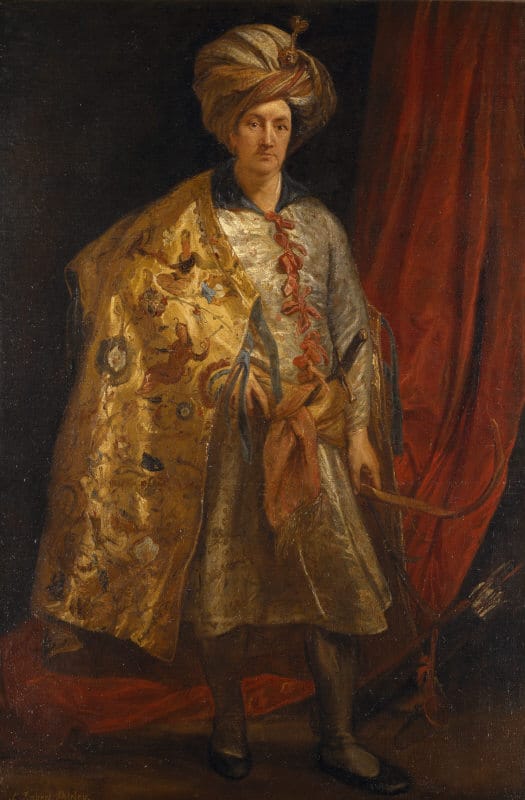
Dressed to impress: an English gentleman fashioned in Persia
One of the treasures of the art collection of Petworth House, located in Sussex in England, is a fascinating pair of portraits by the Flemish artist Anthony Van Dyck. Painted in Rome in 1622, these depict the Englishman Sir Robert Shirley (1581–1628) and his wife Lady Teresa Sampsonia (c.1589–1668). At first glance, these pendant paintings might appear to offer up an epitome of orientalism, in the sense of a European captivation by — but also a kind of appropriation and even a fetishization of — the allure of the Orient. Here we seem to encounter the literal dressing up of an English aristocrat and his wife in the exoticism of the East. Sir Robert is portrayed standing, wearing elaborate Persian attire, including a turban, a silk coat (a qaba) embroided with gold and silver and a sash supporting a curved sword (shamshir). Laid over his right shoulder is a gold overmantel (a balapush) richly embroided with flowers and figures. He holds a bow in his left hand, with the quiver on the ground at right. An expensive-looking red curtain hanging in the background adds to the scene’s showiness.
In the pendant portrait, Lady Shirley is as extravagantly dressed as her husband. She wears a gold dress embroidered with blue and red details and partly covered by a full-length gold and red mantle, which hangs down over the back of her shoulders from the back of her elaborate headdress. She holds a white handkerchief in her right hand, one of whose visual functions would seem to be to bring out the lavishness of the various other objects, fabrics and jewels — including her conspicuous wedding ring, and a tiara with a feather atop her head — which adorn her and the room in which she is depicted. She is shown seated on a divan placed on an opulently coloured Persian carpet, with a red cushion peeking out from the lower right corner of the painting’s canvas. On the other side of the image, a table placed next to the sitter is bedecked with a luxurious blue and gold cloth, upon which a monkey is perched and pulls at an object, possibly a mirror (and so an allusion to vanitas and mortality). In the background there is a red curtain made up of the same material as that in the pendant portrait of Shirley’s husband, and beyond this a distant landscape, which includes a grand building with a square tower, and a vista that perhaps evokes an Italian setting.
What can these paintings tell us about…? Does the elaborate dressing up on display here betoken mainly a personal history, namely the male sitter Sir Robert Shirley’s successes as a broker and go-between in helping to foster contacts between Persia and Europe in the seventeenth century? Or are these images best seen as testimony to a larger nascent European interest in Persia at this historical juncture, with this interesting being one which would then grow apace in the eighteenth century? And how far is the seemingly seamless blending of European and Persian identities in Van Dyck’s paintings a true reflection of the state of relations between Europe and Persia at this period? Perhaps, as this blog post will propose, Shirley’s portrait reveals not so much a cultural encounter wherein Shirley would somehow shed his Englishness for a new exotic and orientalist identity. Instead, the presentation of this gentleman in luxurious silk arguably showcases how the contemporary English engagement with Persia was built upon a nexus of power that was ostensibly geared toward trade, but yet also encompassed hints of future imperial aspirations.
Persia via the Serenissima: the lure of silk
Robert Shirley was born into an aristocratic family in Sussex in the late sixteenth century. Unlike his elder brothers, Thomas and Anthony, he was not educated at Oxford, nor was he admitted to the Inns of Court, but instead he appears to have been sent abroad at a young age for education and advantage. Together with his brothers, Robert would go on to live the life of an adventurer abroad. The trio of Shirley brothers fought in wars across the European continent and served as envoys for kings and princes of North Africa and the Middle East. They met the Tsar of Russia, the Holy Roman Emperor, the Kings of Spain and France, and the pope. Robert converted to Catholicism and married Teresa, the daughter of a powerful Circassian ruler, while his brothers Anthony and Thomas sought to make a fortune as privateers in the Mediterranean and in the Atlantic. Anthony served as a spy for both the Spanish and the Scots and died in poverty in Spain, while Thomas would spend several years imprisoned in the hands of the Turks. The outlandish doings of the brothers — ‘a family not needing hyperboles’, in the words of one contemporary — became celebrated in England where they would be retold in printed pamphlets and in a play on the London stage, The Travailes of the Three English Brothers (1607). The celebrity and literary legacy of the Shirley brothers in some respects looms larger still than their veritable record of activities as ambassadors or middlemen: but even the though many of their ambitious ventures ended in failure, the nature and extent of the Persian connections they fostered remain remarkable.
The Shirley brothers’ engagement with Persia started with Anthony in 1598, two years before Queen Elizabeth I issued the charter creating the East India Company in London. Looking for a way to improve his family’s languishing fortunes, Anthony had accepted the proposal of his patron, the Earl of Essex, to conduct a small company of English volunteers to take part in a potential coup in Ferrara in Italy. But when that mission was overtaken by political events and so proved to be futile, Anthony instead proceeded to Venice, where he was joined by Robert. Together, they decided to travel on to Persia. In the early 1600s, Safavid Persia was emerging as a strong political power thanks to the reforms conducted by Shah Abbas, who had gained the sobriquet of ‘the Great’ for his actions. The arts and trade were flourishing after decades of decline, and despite near-constant wars with the Ottoman Empire.
Why did the two brothers take such a decision? It may be that Anthony and Robert simply decided on their own initiative to seek a fortune far away from Europe. While in Venice, the brothers may have been enticed by the stories told by merchants there about Persia’s riches and especially about the silk trade. Venice had long-established commercial ties with the Ottoman Empire and Persia, with the Serenissima forming a trading hub between the East and Europe for the resale of silk and other goods from the Orient since the thirteenth century. During the Shirley brothers’ own lifetimes, the production of finished cloth from raw silk had become a major industry in European countries, and Persian raw silks, known for their great quality, were a highly desirable commodity. Huge profits were being made by Venetian merchants selling raw silk from Persia to European countries with emerging silk industries. The Shirleys would certainly not be the first to try to cut out these middlemen and find a direct route for this raw silk trade.
The Shirley brothers’ voyage may, conceivably, have received some degree of official sanction from the English state. At any rate, there are some hints of larger diplomatic projects around this juncture aimed at persuading the Shah to join forces with Christian states against their mutual enemy, the Ottoman Empire, and at improving commercial relations with Persia so that England might gain direct access to the Persian silk trade. One lucrative prospect was that Persian raw silk might be exchanged for English wools instead of cash. Attempts to penetrate the Persian silk market were not without precedent, notably with an effort in the mid-1560s by merchants of the English Muscovy Company: but such bids had mostly failed. Given that the Shirleys were well-connected in Westminster, with close family members sitting in Parliament, Anthony and Robert’s expedition might have met with at least tacit countenance from government. The Earl of Essex also seems, in his correspondence with Anthony, to have offered exhortations about the value of seeking out prospects for English navigation and trade in the East.
Around the spring of 1599, Robert and Anthony left for Persia on the ship of a Venetian merchant bound for the Levant. The voyage proved eventful, just like the rest of the brothers’ lives, with a quarrel between Anthony and the crew resulting in him and Robert being obliged to disembark at Zante. The Shirleys finally reached Qazvin in Persia in late 1599 and were well received at Shah Abbas’s court. Anthony was granted the honorary title of ‘mirza’ and, several months later, in spring 1600, he was sent to Europe by the Shah as a diplomatic envoy, with Robert remaining in Persia in an equivocal position of guest but also hostage. The aim of Anthony’s mission to Europe was to engineer an alliance between the Safavid state and Christian powers in Europe against the Turks. Anthony’s party, which also included a Persian fellow envoy, Hasain Ali Beg Bayat, was charged with bringing diplomatic letters not just to Elizabeth I but also to the Pope, the Holy German Emperor, the Doge of Venice, and the Kings of France, Spain, Scotland and Poland. The diplomatic expedition also bore assorted gifts for these rulers. The venture’s highpoint came in late 1600 when it presented its credentials to the Holy Roman Emperor, Rudolph II, who indicated a willingness to conduct joint operations against the Ottomans. Rudolph went as far as despatching his own diplomatic mission to Persia, and yet his ambassador died before reaching Shah Abbas’s court. The rest of Anthony’s expedition proved far less successful. In Rome, he fell out with his fellow envoy Hasain Ali Beg Bayat. At this point, Anthony appears to have in effect broken off his role in the mission, thereby leaving his brother to an uncertain fate in Persia.
Persian connections and company politics
In the event, Robert would remain in Persia for several more years. Without news from his brother, Robert apparently served for a period as an advisor to Shah Abbas in his attempt to reorganise his army. Alarmed by the prospect of a peace between the Holy Roman Empire and the Ottomans, Shah Abbas ultimately decided to send a second mission to the Christian rulers of Europe, led this time by Robert, with the expedition’s most ambitious goals to conclude an alliance against the Ottomans and to change the geography of the silk route. In the early seventeenth century, most of the silk trade for Europe transited via Constantinople. One of Shah Abbas’s aspirations was to reorient the silk trade around the Persian Gulf area. This was rendered thinkable by his military successes and the subjugation in the late sixteenth century of the Caspian area, which was the centre of silk production. Control of silk production and trade was an important component of Shah Abbas’s centralizing policies.
Robert left Persia with his wife Teresa in February 1608 and visited Poland, the Holy Roman Empire, Florence and other Italian cities before reaching Rome, where he presented himself attired in distinctive Persian clothing and with a gold crucifix affixed to his turban. While his encounter with the pope appears to have gone well, the next stopping point of the mission, at the court of the King of Spain, occasioned drawn-out negotiations which were then undercut by the arrival of another Persian envoy in Spain in 1611. Robert next decided to head to England. He met with James I at Hampton Court in 1611 where he presented Shah Abbas’s proposal to give English merchants access to designated Persian ports and a possible monopoly over the silk trade. While this prospect met with interest on the part of the King, negotiations dragged on because of the opposition of the English Levant Company. Incorporated by royal charter granted by Elizabeth I in 1581, the Levant Company held a trading monopoly with the Ottoman Empire and with Venice. Its merchants made huge profits in the silk trade. If put into practice, the Persian plan would re-anchor the silk trade in the Gulf region, and so would threaten the Ottomans and be damaging to the Levant Company’s shipping with Constantinople and the Eastern Mediterranean. Pressure from Levant Company merchants and a brief peace between the Ottomans and Safavid Persia combined to thwart Robert’s mission, and in early 1613 he left for Persia. His return journey proved eventful, with a detour via the Indian subcontinent, where he was received by the Mughal emperor Jahangir and met Thomas Kerridge, the representative in Surat of the recently created East India Company. Robert gave Kerridge information about Persian ports which might prove serviceable to East India Company shipping, before finally returning to the court of Shah Abbas in 1615.
Robert did not stay long, as Shah Abbas sent him on a second mission, this time to seek Spanish support to expel the Portuguese from Hormuz. Before leaving, Robert assisted Richard Steel and John Crouther, the first East India Company agents to establish a footing in Persia, to obtain a number of trading dispensations. This quickly fostered a commerce centred on the importation of English broadcloth to Persia for exchange with Persian silk which was then brought back to England.
Robert and Teresa arrived in Spain in 1617 and remained there until 1622, before heading to Rome — and to Van Dyck’s studio — and then on to England. In 1624, Robert had another audience with James I. The envoy put forward a scheme which would give English merchants a monopoly over the Persian silk trade. The King was taken with the idea, but Robert’s proposal met with opposition from representatives of the East India and Levant companies. They raised concerns about the capacity of the European market to absorb so much silk and feared that such a scheme would damage their India and Ottoman commercial interests. James I died in 1625. Although his successor Charles I was eager to pursue a Persian connection, Robert’s position was compromised by the arrival at the court of a second envoy from the Shah, Naqd Ali Beg. Against a backdrop of tension between Shirley and Naqd Ali Beg, Charles I decided to send Sir Dodmore Cotton as the first accredited English ambassador in Persia. Shirley was to accompany him. The party sailed for Persia on an East India Company ship, The Star. After a final meeting with the Shah, but now somewhat put into the shade by Cotton, Shirley died in July 1628 at Qazvin. Lady Shirley retired in Rome and in 1658 she had the remains of her husband transferred from Persia to the Church of Santa Maria in Trastevere, where she herself would later be buried.
Shirley has sometimes been seen as an indeterminate interloper figure, whose role as an envoy may never have been formally accredited by Shah Abbas. The nature of his relations with the East India Company is also somewhat murky. But such objections are, arguably, somewhat misplaced: for his activities certainly contributed to a diplomatic rapprochement between England and Safavid Persia which facilitated the strengthening of English trading positions in Persia and in the wider Gulf region. In fact, in 1622, Anglo–Safavid relations would be substantively bolstered by their military cooperation in an expedition which resulted in the expulsion of the Portuguese from Hormuz. Shah Abbas’s desire to reduce the Portuguese trading might in his empire had found an echo with the East India Company’s ambitions to penetrate the Persian silk market. The prize for the assistance of English ships had been a firman (a royal decree from an Islamic ruler) which included a concession allowing English merchants to trade in silk throughout Persia free of custom charges. The firman gave East India Company merchants a favourable position compared to their Dutch rivals, who only enjoyed the right to purchase a fixed quantity of silk at fixed rates. After the granting of the firman, the East India Company opened factories in Shiraz, Jask, Isfahan and Kerman and traded silks and other products to England and India through the port of Bunder Abbas.
The firman of 1622 was foundational in the history of the establishment of the East India Company’s commercial and political empire in the Persian Gulf region. It gave the Company a possibility of operating profitably in the vast Safavid Empire from a small trading hub while developing strong political relations with the second most powerful political power in the Middle East after the Ottomans. While the silk trade ebbed over the second half of the seventeenth century, nevertheless the Company’s political ambitions in Persia and in the Persian Gulf developed in the eighteenth and nineteenth centuries. Under the weakened Qajar dynasty, Persia would become a buffer state of the semi-autonomous British Empire in India. Seen in this light, Robert Shirley’s portrait may look a little less like a picture of a peaceful encounter between Persia and England, and instead betokened an early step in a process of gradual subjugation of the Persian state’s political independence to the emerging trading but also territorial ambitions of an East India Company which would go on to become the region’s dominant imperial power.
Robert Shirley’s travels and brokering between Europe and Persia also help better understand the workings of the so-called ‘factory’ system in the East, whereby European trading companies gained port access and territorial concessions with which they sought a footing in global commerce. In order to trace the origins and operating contexts of these trading centres and emergent hubs of a globalising economy, we need to take into consideration not just questions of goods, commerce and shipping, but also the role of background diplomatic exchanges and, not least, of figures such as Shirley. Such seemingly quixotic characters often played an outsized part in sometimes helping, sometimes hindering the growing ambitions of European chartered trading companies over the early modern period.
